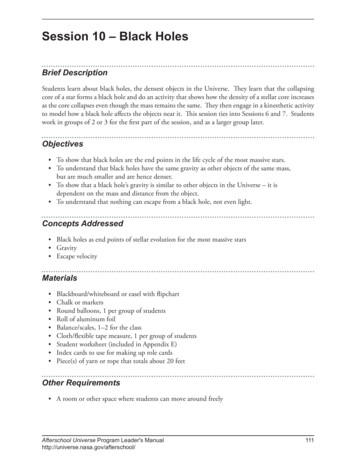Data Assimilation Activities At - Tandeo.files.wordpress
Data Assimilationactivities atIMT AtlantiqueWorkshop on Data AssimilationIMT Atlantique Brest - Feb 22, 20191Pierre Tandeo - pierre.tandeo@imt-atlantique.fr
OutlineI- DA applications at IMT AtlantiqueII- Mathematical formulation of DAIII- Analog DAIV- Uncertainty quantification in DAV- Conclusions and perspectives
I- Data Assimilation applications at IMT AtlantiqueSynergy in spatial oceanography Satellite observations from differentsensors Various observed variables(temperature, salinity, currents) Different spatial and temporalresolutions Observations only at the surface.3
I- Data Assimilation applications at IMT AtlantiqueNumerical simulations of the ocean Integration of physical equations (atdifferent depths) Consistency between variables Same spatial and temporal resolution Useful to get forecasts but we need agood initial condition4
II- Mathematical formulation of Data AssimilationBridge between observations and simulations5
II- Mathematical formulation of Data AssimilationNonlinear state-space model6Estimation ofp(x y) usingEnsemble Kalman
III- Analog Data AssimilationGeneral concept7
III- Analog Data AssimilationMathematical formulation8
III- Analog Data AssimilationModel-driven VS Data-driven9Both methods areequivalent for largeenough catalog
III- Analog Data AssimilationComparison with other data-driven methods (model is unknown) Exact interpolator: linear, cubic or splines no error in observations Smoothers: Optimal Interpolation (OI) or AnDA errors in observations need historical data to learn temporal dependencies10
III- Analog Data AssimilationComparison with other data-driven methodsRealistictrajectory usinganalogsAdaptiveuncertaintiesusing analogs11
III- Analog Data AssimilationApplications in spatial oceanographyExample for the interpolation of along-track SSH:12
IV- Uncertainty quantification in Data AssimilationGeneral variances
IV- Uncertainty Quantification in Data AssimilationMathematical formulation14
IV- Uncertainty Quantification in Data AssimilationApplications in spatial oceanography15Bad modelspecificationStrongsatelliteerrorsExample for the interpolation of infrared SST:
V- Conclusions and perspectivesConclusions and references Data-driven methods in DA: use historical data from observations or numerical simulations use machine learning for the emulation of the model use statistical algorithms for uncertainty quantification Analog DA: Lguensat, R., Tandeo, P., Ailliot, P., Pulido, M., & Fablet, R. (2017). Theanalog data assimilation. Monthly Weather Review, 145(10), 4093-4107. https://github.com/ptandeo/AnDA Uncertainty quantification in DA: Dreano, D., Tandeo, P., Pulido, M., Ait‐El‐Fquih, B., Chonavel, T., &Hoteit, I. (2017). Estimating model‐error covariances in dtheexpectation–maximization algorithm. Quarterly Journal of the RoyalMeteorological Society, 143(705), 1877-1885. https://github.com/ptandeo/CEDA16
V- Conclusions and perspectives17Other activities and perspectives Joint estimation of Q and R in DA: 1st collaboration betweenRIKEN and IMT Atlantique review paper in revision with T. MiyoshiNowcasting of extreme rainfalls: 2st collaboration between RIKENand IMT Atlantique use deep learning methods with T. Miyoshi and S. Otsuka (talk) Others applications at IMT Atlantique: use neural network in DA (S. Ouala talk) image processing and optimization techniques (L. Drumetz talk)
Thank you!Any questions?18
Workshop on Data Assimilation IMT Atlantique Brest - Feb 22, 2019 1. I- DA applications at IMT Atlantique II- Mathematical formulation of DA III- Analog DA IV- Uncertainty quantification in DA V- Conclusions and perspectives Outline. . and IMT Atlantique use deep learning methods
The Executive Assimilation Workshop Process Phase 1 - Introduction Assimilation begins with a brief Introductory Presentation to the Senior Management Team and the new Executive. The presentation outlines the goals for the assimilation, the phases to be followed and the work ahead. It also provides an opportunity for the
1.2 Data assimilation for adaptive mesh models: the issue Data assimilation (DA) is the process by which data from observations are assimilated into a computational model of a physical system. There are numerous mathematical approaches, and associated numerical techniques, for ap-proac
which is the language of Qur'ān (Al- Hamad, 1995: 15). 2. Data Collection and Method of Analysis. . classifying assimilation into historical and contextual. Historical assimilation is defined as the change which has taken place in the course of time due to the development of language, as in "words" which is pronounced /wз:dz/ instead of .
Contrary to the melting-pot image, assimilation in the United States generally has been a coercive and largely one-sided process better described by the terms . Americanization. or . Anglo-conformity. Rather than an equal sharing of elements and a gradual blending of diverse peoples, assimilation in the United States was designed to maintain .
Assimilation Key to Successful Implementation of Statewide Case Management Systems: . planning and communication take trial court questions and concerns seriously especially if, as was true in Arizona, previous projects failed to assimilate the trial courts. . it is paramount that the project manager keeps assimilation where it should be .
conventional observation processing along with NCAR’s Data Assimilation Research Testbed (DART) toolkit for assimilation of conventional and radar observations; and 4) two analysis and forecast system implementations will be developed and demonstrated at the testbed activities. Dec. 30, 2016 Abstract 1
Data Assimilation in the Ionsphere (Hsu, Matsuo, Wang, Liu, 2014) Using TIEGCM . Question: Does Data Assimilation Work in the ionosphere? Answers: Assimilating only electron and ion data does not work very well Assimilating winds and temperatures helps a little Neutral composition is the most important parameter for
Session 10 – Black Holes. Brief Description. Students learn about black holes, the densest objects in the Universe. They learn that the collapsing . core of a star forms a black hole and do an activity that shows how the density of a stellar core increases as the core collapses even though the mass remains the same. They then engage in a kinesthetic activity to model how a black hole affects .























